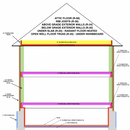Insulation Critique
Hi guys, I’m going to be starting a new build soon in zone 5. I wanted to get some advice on my insulation thoughts before I take it to some insulation companies for quotes. I don’t want them talking me in or out of anything based on their bias. Please take a look at my illustration and let me know what you think/recommend. I know that radiant floors in a low load house may be overkill (especially warmboard $$$), but I just prefer radiant heat to forced air for heating. Some may say money wasted, but not this guy.
I’ve been going back and forth with the best way to insulate under the warmboard panels as they recommend R-20. I’ve got 14 inch open well floor trusses on the first and 12 inch on the second and think open cell foam is the best way to do it, and it leaves space at the bottom of the cavity for plumbing and electrical etc…
the other thing I’m wondering if it’s ok to closed cell spray foam on top of EPS under the slab? I know I could just use more EPS, but I like the thought of the monolithical layer of spray foam right up to the rim joists.
All opinions are appreciated. Many thanks.
Chris
GBA Detail Library
A collection of one thousand construction details organized by climate and house part










Replies
You never design SPF into a new build. There are much cheaper ways of air sealing a house that require very little additional work.
I've never seen SPF bellow grade, I can't see what it does there that couldn't be done by a bit of extra rigid+poly.
Poured concrete walls are easily insulated with rigid insulation, no need for SPF.
For thermal isolation between zones you only need about R8 of insulation. Cheapest batts you can stuff into the joist bays work for this, air sealing or quality install hardly matters for this. Again, SPF is a very expensive solution to this problem.
Rigid mineral wool is not a common material outside of commercial world. If you do want to use it, make sure your builder is familiar with it. Not the easiest material to work with as it is still somewhat squishy, takes a lot of work to get the strapping flat so your siding won't be wavey.